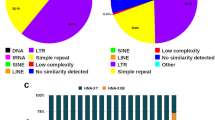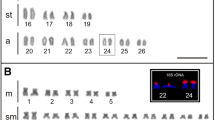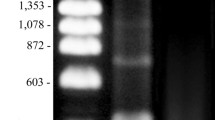Abstract
Three novel repetitive DNA sequences are described, presenting a similar heterochromatic chromosomal location in two hamster species: Phodopus roborovskii and Phodopus sungorus (Cricetidae, Rodentia). Namely, two species-specific repetitive sequences (PROsat from P. roborovskii and PSUchr1sat from P. sungorus) surrounding a third one (PsatDNA), that is shared by both hamster genomes. Fiber-FISH analyses revealed that PROsat intermingles with PsatDNA in P. roborovskii and PSUchr1sat intermingles with PsatDNA in P. sungorus. A model explaining the evolution of this intricate chromosomal distribution is proposed, which can explain better the evolution of these very derivative genomes (in comparison to the ancestral Muroidea). The most plausible evolutionary scenario seems to be the expansion of a number of repeats into other’s domain, most probably resulting in its intermingling, followed by the subsequent spread of these complex repeats from a single chromosomal location to other chromosomes. Evidences of an association between repetitive sequences and the chromosome evolution process were observed, namely for PROsat. Most probably, the evolutionary breakpoints that shaped PRO and PSU chromosomes (pericentric inversions and fusions) occurred within the boundaries of PROsat blocks in the ancestor. The repeats high diversity at the heterochromatic regions of Phodopus chromosomes, together with its complex organization, suggests that these species are important models for evolutionary studies, namely in the investigation of a possible relationship between repetitive sequences and the occurrence of chromosomal rearrangements and consequently, in genome evolution.






Similar content being viewed by others
Abbreviations
- 3′UTR:
-
3′ untranslated region
- 5′TAMRA:
-
5′ Carboxytetramethylrhodamine
- APK:
-
Ancestral Phodopus Karyotype
- BLAST:
-
Basic Local Alignment Search Tool
- CBP-banding:
-
C-bands by barium hydroxide with propidium iodide
- CCR:
-
Cricetus cricetus
- EMBOSS:
-
European Molecular Biology Open Software Suite
- Fiber-FISH:
-
FISH on stretched chromatin fibers
- FISH:
-
fluorescent in situ hybridization
- FITC:
-
fluorescein isothiocyanate
- LINE-1:
-
long interspersed nuclear element-1
- NCBI:
-
National Center for Biotechnology Information
- ORF2:
-
open reading frame 2
- PCR:
-
polymerase chain reaction
- PER:
-
Peromyscus eremicus
- PRO:
-
Phodopus roborovskii
- PROsat:
-
Phodopus roborovskii satellite
- PsatDNA:
-
Phodopus satellite DNA
- PSU:
-
Phodopus sungorus
- PSUchr1sat:
-
Phodopus sungorus chromosome 1 satellite
- REs:
-
restriction enzymes
- RNO:
-
Rattus norvegicus
- SatDNAs:
-
Satellite DNAs
References
Adega F, Guedes-Pinto H, Chaves R (2009) Satellite DNA in the karyotype evolution of domestic animals—clinical considerations. Cytogenet Genome Res 126:12–20
Batistoni R, Pesole G, Marracci S, Nardi I (1995) A tandemly repeated DNA family originated from SINE-related elements in the european plethodontid salamanders (amphibia, urodela). J Mol Evol 40:608–615
Belyayev A (2014) Bursts of transposable elements as an evolutionary driving force. J Evol Biol 27(12):2573–84
Benson G (1999) Tandem repeats finder: a program to analyze DNA sequences. Nucleic Acids Res 27(2):573–580
Biscotti MA, Canapa A, Olmo E et al (2007) Repetitive DNA, molecular cytogenetics and genome organization in the King scallop (Pecten maximus). Gene 406:91–98
Bruvo B, Pons J, Ugarković Đ, Juan C, Petitpierre E, Plohl M (2003) Evolution of low-copy number and major satellite DNA sequences coexisting in two Pimelia species-groups (Coleoptera). Gene 312:85–94
Carleton MD, Musser GG (2005) Order Rodentia. In: Wilson DE, Reeder DM (eds) Mammal species of the world: a taxonomic and geographic reference, 3rd edn. Johns Hopkins University Press, Baltimore, pp 745–1601
Chaves R, Frönicke L, Guedes-Pinto H, Wienberg J (2004) Multidirectional chromosome painting between the Hirola antelope (Damaliscus hunteri, Alcelaphini, Bovidae), sheep and human. Chromosom Res 12:495–503
Chaves R, Guedes-Pinto H, Heslop-Harrinson P (2005) Phylogenetic relationships and the primitive X chromosome inferred from chromosomal and satellite DNA analysis in Bovidae. Proc R Soc B 272:2009–2016
Cheng ZJ, Murata M (2003) A centromeric tandem repeat family originating from a part of Ty3/gypsy–retroelement in wheat and its relatives. Genetics 164:665–672
Cridland JM, Thornton KR, Long AD (2014) Gene expression variation in Drosophila melanogaster due to rare transposable element insertion alleles of large effect. Genetics 199(1):85–93
Dover G (2002) Molecular drive. Trends Genet 18:587–589
Elder JF, Turner BJ (1995) Concerted evolution of repetitive DNA sequences in eukaryotes. Q Rev Biol 70:297–320
Enukashvily NI, Ponomartsev NV (2013) Mammalian satellite DNA: a speaking dumb. Adv Protein Chem Struct Biol 90:31–65
Grewal SIS, Jia S (2007) Heterochromatin revisited. Nat Rev 8:35–46
Guenatri M, Bailly D, Maison C, Almouzni G (2004) Mouse centric and pericentric satellite repeats form distinct functional heterochromatin. J Cell Biol 166(4):493–504
Hall LE, Mitchell SE, O’Neill RJ (2012) Pericentric and centromeric transcription: a perfect balance required. Chromosom Res 20:535–546
Heikkinen E, Launonen V, Muller E, Bachmann L (1995) The pvB370 BamHI satellite DNA family of the Drosophila virilis group and its evolutionary relation to mobile dispersed genetic pDv elements. J Mol Evol 41:604–614
Kapitonov VV, Jurka J (1999) Molecular paleontology of transposable elements from Arabidopsis thaliana. Genetica 107:27–37
Kapitonov VV, Holmquist GP, Jurka J (1998) L1 repeat is a basic unit of heterochromatin satellites in cetaceans. Mol Biol Evol 15(5):611–612
López-Flores I, de la Herrán R, Garrido-Ramos MA, Boudry P, Ruiz-Rejón C, Ruiz-Rejón M (2004) The molecular phylogeny of oysters based on a satellite DNA related to transposons. Gene 339:181–188
Louzada S, Paço A, Kubickova S et al (2008) Different evolutionary trails in the related genomes Cricetus cricetus and Peromyscus eremicus (Rodentia, Cricetidae) uncovered by orthologous satellite DNA repositioning. Micron 39:1149–1155
Macas J, Koblížková A, Navrátilová A, Neumann P (2009) Hypervariable 3′ UTR region of plant LTR-retrotransposons as a source of novel satellite repeats. Gene 448:198–206
Marchal JA, Acosta MJ, Bullejos M, Puerma E, Díaz de la Guardia R, Sánchez A (2006) Distribution of L1-retroposons on giant sex chromosomes of Microtus cabrerae (Arvicolidae, Rodentia): functional and evolutionary implications. Chromosom Res 14:177–186
Mayorov VI, Adkison LR, Vorobyeva NV et al (1996) Organization and chromosomal localization of a B1-like containing repeat of Microtus subarvalis. Mamm Genome 7:593–597
Ohno S (1972) So much “junk” DNA in our genome. In: Smith HH, ed. Evolution of genetic systems. New York: Gordon and Breach. Brookhaven Symp Biol, pp 366–370
Paço A, Chaves R, Vieira-da-Silva A, Adega F (2013) The involvement of repetitive sequences in the remodelling of karyotypes: the Phodopus genomes (Rodentia, Cricetidae). Micron 46:27–34
Paço A, Adega F, Meštrović N, Plohl M, Chaves R (2014) Evolutionary story of a satellite DNA from Phodopus sungorus (Rodentia, Cricetidae). Genome Biol Evol 6(10):2944–2955
Paço A, Adega F, Chaves R (2015) Line-1 retrotransposons: from “parasite” sequences to functional elements. J Appl Genet 56:133–145
Pezer Ž, Ugarković Đ (2008) Role of non-coding RNA and heterochromatin in aneuploidy and cancer. Semin Cancer Biol 18:123–130
Plohl M (2010) Those mysterious sequences of satellite DNAs. Period Biol 112(4):403–410
Plohl M, Meštrović N, Mravinac B (2014) Centromere identity from the DNA point of view. Chromosoma 123(4):313–325
Rebollo R, Romanish MT, Mager DL (2012) Transposable elements: an abundant and natural source of regulatory sequences for host genes. Annu Rev Genet 46:21–42
Richard GF, Kerrest A, Dujon B (2008) Comparative genomics and molecular dynamics of DNA repeats in eukaryotes. Microbiol Mol Biol Rev 72(4):686–727
Romanenko SA, Volobouev VT, Perelman PL et al (2007) Karyotype evolution and phylogenetic relationships of hamsters (Cricetidae, Muroideia, Rodentia) inferred from chromosomal painting and banding comparison. Chromosom Res 15:283–297
Rossi MS, Pesce CG, Reig OA, Kornblihtt AR, Zorzópulos J (1993) Retroviral-like features in the repetitive unit of the major satellite DNA from the South American rodents of the genus Ctenomys. DNA Seq 3:379–381
Santos S, Chaves R, Guedes-Pinto H (2004) Chromosomal localization of the major satellite DNA family (FA-SAT) in the domestic cat. Cytogenet Genome Res 107:119–122
Schwarzacher T, Heslop-Harrison JS (2000) Practical in situ hybridization, 1st edn. Bios Scientific Publishers, Oxford, pp 1–199
Sharma A, Wolfgruber TK, Presting GG (2013) Tandem repeats derived from centromeric Retrotransposons. BMC Genomics 14(142):1–11
Slamovits CH, Rossi MS (2002) Satellite DNA: agent of chromosomal evolution in mammals. A review. J Neotropical Mamm 9(2):297–308
Sumner AT (1972) A simple technique for demonstrating centromeric heterochromatin. Exp Cell Res 75:304–306
Thompson JD, Higgins DG, Gibson TJ (1994) Clustal W: improving the sensitivity of progressive multiple sequence alignment through sequence weighting, position specific gap penalties and weight matrix choice. Nucleic Acids Res 22(22):4673–4680
Verma RS, Babu A (1995) Human chromosomes—principles and tecniques, 2nd edn. McGraw-Hills Book Company, New York, pp 1–419
Vittorazzi SE, Lourenço LB, Recco-Pimentel SM (2014) Long-time evolution and highly dynamic satellite DNA in leptodactylid and hylodid frogs. BMC Genet 15(111):1–11
Walsh JB (1987) Persistence of tandem arrays: implications for satellite DNA and simple-sequence DNAs. Genetics 115:553–567
Wong LH, Choo KHA (2004) Evolutionary dynamics of transposable elements at the centromere. Trends Genet 20(12):611–616
Wong LH, Brettingham-Moore KH, Chan L et al (2007) Centromere RNA is a key component for the assembly of nucleoproteins at the nucleolus and centromere. Genome Res 17(8):1146–1160
Zhu Q, Pao GM, Huynh AM et al (2011) BRCA1 tumour suppression occurs via heterochromatin-mediated silencing. Nature 477(7363):179–184
Acknowledgments
This work was funded by the project POCI/BIA-BCM/58541/2004, a PhD grant (SFRH/BD/41574/2007), and a research position on Animal Genomics of the “Sistema Científico e Tecnológico Nacional—Ciência 2007”, all from the Science and Technology Foundation (FCT) from Portugal. We are deeply grateful to Dr. Vitaly Volobouev for providing the C. cricetus and P. eremicus cell cultures.
Compliance with Ethical Standards
This research is in agreement with the current laws of the country in which they were performed. This article does not contain any studies with human or animal subjects performed by the any of the authors. All the authors are in agreement to the submission of this manuscript to Chromosome Research.
Conflict of interest
All authors declare that they have no competing interests.
Author information
Authors and Affiliations
Corresponding author
Additional information
Responsible Editors: Maria Assunta Biscotti, Pat Heslop-Harrison and Ettore Olmo
Rights and permissions
About this article
Cite this article
Paço, A., Adega, F., Meštrović, N. et al. The puzzling character of repetitive DNA in Phodopus genomes (Cricetidae, Rodentia). Chromosome Res 23, 427–440 (2015). https://doi.org/10.1007/s10577-015-9481-9
Published:
Issue Date:
DOI: https://doi.org/10.1007/s10577-015-9481-9




